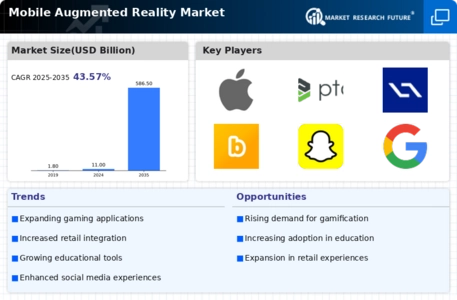Top Industry Leaders in the Mobile Augmented Reality Market

Competitive Landscape of Mobile Augmented Reality Market
The mobile augmented reality (AR) market is a dynamic and rapidly evolving landscape, with a diverse range of players vying for dominance. Key players in this space have adopted a variety of strategies to gain market share and establish their competitive edge. Understanding these strategies and the factors that contribute to market share is crucial for companies seeking to enter or expand their presence in the mobile AR market.
Key Players and Strategies
- Qualcomm Inc. (U.S.)
- Microsoft Corporation (U.S.)
- Samsung Electronics Ltd. (South Korea)
- Catchoom Technologies (Spain)
- HCL Technologies Limited (India)
- Apple Inc. (U.S.)
- Intel Corporation (U.S)
- DAQRI (U.S.)
- Google Inc. (U.S.)
- Elsevier (Netherlands)
- SAP SE (Germany)
- CORDIS (U.S)
- Blippar (U.K.)
- Infinity augmented reality (Israel)
Factors for Market Share Analysis
Several factors contribute to a company's market share in the mobile AR market. These factors include:
Product and platform capabilities: The quality and capabilities of a company's AR platform, applications, and hardware are critical to attracting users and gaining market share.
User base: A large and engaged user base is essential for a company to successfully monetize its AR offerings.
Partnerships and ecosystem: Strong partnerships with device manufacturers, app developers, and other key players in the AR ecosystem can provide a company with a competitive advantage.
Marketing and brand awareness: Effective marketing and branding can help a company to differentiate itself from its competitors and attract new users.
New and Emerging Companies
The mobile AR market is constantly evolving, and new and emerging companies are entering the space with innovative products and services. These companies are often able to disrupt the market and challenge the dominance of established players.
Some of the emerging trends in the mobile AR market include:
Enterprise adoption: AR is increasingly being adopted by businesses for training, remote assistance, product visualization, and other applications.
Wearable devices: AR glasses and other wearable devices are poised to play a major role in the future of mobile AR.
AR for education: AR is being used to create immersive and engaging learning experiences for students of all ages.
AR for healthcare: AR is being used to improve patient care, medical training, and surgical procedures.
Current Company Investment Trends
Mobile AR is a hot area of investment, and companies are pouring money into developing new technologies, products, and applications. Some of the key investment trends in the mobile AR market include:
Increased focus on AR glasses: Investors are increasingly interested in AR glasses, as they have the potential to provide a more immersive and natural AR experience.
Development of mobile AR applications for businesses: Companies are investing in developing mobile AR applications that can help businesses improve productivity, efficiency, and customer service.
Integration of AR into existing products and services: Companies are looking for ways to integrate AR into their existing products and services, such as smartphones, tablets, and cars.
Updated News:
January 25, 2024: Meta announces plans to integrate AR into its Quest headsets. Meta, the parent company of Facebook, is reportedly planning to integrate AR into its Quest headsets, which could make them more versatile and appealing to a wider range of users. This move could also help Meta to compete with other companies that are developing AR headsets, such as Apple and Google.
January 24, 2024: Snapchat introduces AR shopping tools. Snapchat has introduced a new set of AR shopping tools that allow users to try on virtual clothes and accessories. This could help to make shopping more interactive and engaging for users, and it could also lead to increased sales for retailers.
January 23, 2024: Google releases new ARCore features. Google has released new features for its ARCore platform, which allows developers to create AR experiences for Android devices. These new features include improved object detection and tracking, as well as support for more realistic lighting and shadows.










